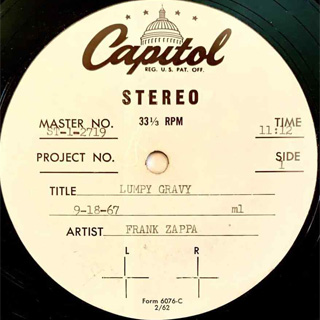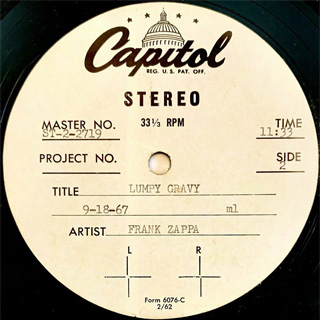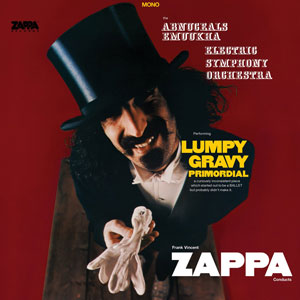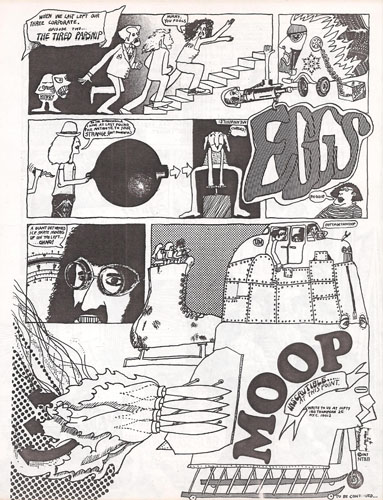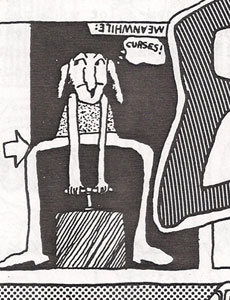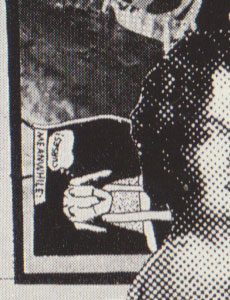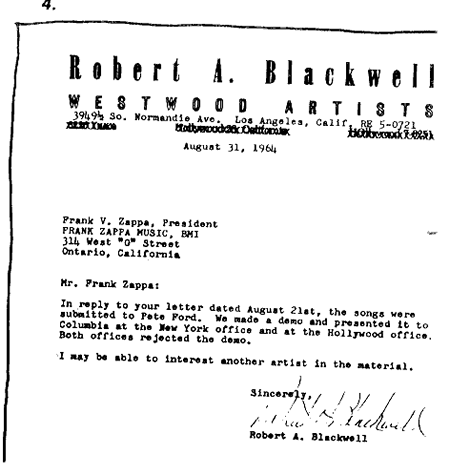The Original Album
LPs
[...] [Frank Zappa] Lumpy Gravy (cancelled; only LP slicks exist—see 4-track tape listing below) Capitol TAO/STAO-2719 08/07/67
[...]
4-TRACK CARTRIDGES (ESSENTIAL RELEASES ONLY)
[Frank Zappa] Lumpy Gravy (quickly recalled) Muntz Stereo-Pak 4CD-2719 08/07/67
The Paper, Summer, 1967, p. 24
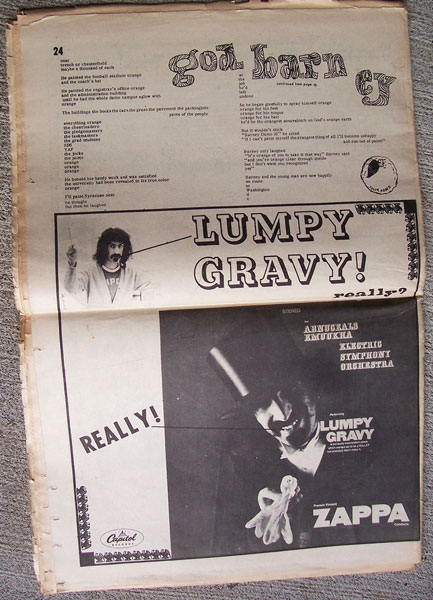
Frank Zappa, mother-mother, thinker, something of a success.
A producer for MGM (he produces the Mothers for them). A composer for Capitol. He's created and conducted a ballet for them, "Lumpy Gravy." He wants a puppeteer to do the choreography.
"Originally what happened was that right after the completion of Absolutely Free in '66, the basic tracks were cut for Lumpy Gravy in Los Angeles. This guy Nick Venet—a producer at Capitol—heard I could write orchestra music and asked me if I'd like to do an orchestra album for Capitol because my MGM contract didn't preclude me from conducting. I wasn't signed as a conductor and since I wasn't performing on the album, there didn't seem to be any problem. He gave me a budget for a 40-piece orchestra, x-number of studio hours, and said go do it. And I did." As MGM's legal department would have it, a problem did arise. When Zappa brought the orchestral tapes to New York for mixing, MGM complained about it—after Capitol had spent over $30,000 on the album. Capitol was even ready to release it.
"In fact, if you're looking for rare collectors' items, there are 8-track tapes with the Capitol label of Lumpy Gravy that have a different Lumpy Gravy than the album. Those have only the orchestral music and they do exist." Eventually MGM gave Capitol their 30 grand back for the master LG tapes, and Zappa added "all that talking and stuff" later. But the litigation cost Zappa and his album 13 months before it could be released.
In '66, I used to live in this little house on Kirkwood, and I was renting this place, and this right about the time Venet offered me this opportunity to write this music. I thought "Whoa! This is fabulous. I'll just dive in there and start composing my little buns off, and I'll get this performance." Well, shortly after receiving this commission, the landlord notifies me that his son, who is a dentist from the Midwest, is moving back to California, and we should get out of the house, so he can have his son move in. So, I got evicted. I have to move. I've got a deadline to do the recording session, I've got all this music to write, and I've got no place to do it. So Lumpy Gravy, all the music to that was written in these locations: the office adjoining Nick Venet's office at Capitol Records, after six PM, 'cause they had a little piano in there, and I would go down there, and work in there for a few hours; then I wrote part of it at the Tropicana Motel, with no piano, because we had to live there; and then, um, I took a short-term rental on another house in the Canyon, just prior to the recording sessions, and I was writing around the clock, and I had copyists coming over there at three o'clock in the morning and pick up chunks of the score, and go off, and copy the parts, OK? So, to answer your question, where do these titles come from? You gotta name these segments something, because you have pieces of it going out the door. It wasn't one whole finished thing, 'cause it had to be done in an assembly-line process, so . . . there ya go, "Sink Trap".
In 1966, a guy who was staff producer for Capitol Records named Nick Venet came to me, and he said, "How would you like to do some music with an orchestra?" and I said, "An Orchestra? Why that would be wonderful!" He says, "Yeah, 40 pieces!" I said, "Wow, what a wonderful large orchestra!" It just so happened, though, that time I was under contract to Verve, and so the question came up was I under contract as a composer and conductor? And I said, "No, I was signed as a rock n roll musician who is a singer in a group. And he presumed, and I thought that he would have checked it with his legal department, that it would be OK to go ahead and produce such a record not there wouldn't be any problems about it, so I went ahead and did it, and the next thing we knew there were problems about it, so they argued for 13 months, it took from the time that the album was done, to the time it came out was 13 months, they finally settled it by Verve purchasing it outright from Capitol.
The Musicians
Original album credits
PIANO, CELESTE, ELECTRIC HARPSICHORD:
Paul Smith
Mike Lang
Lincoln Mayorga
Pete Jolly
DRUMS:
Johnny Guerin
Frankie Capp
Shelly Manne
PERCUSSION (Gongs, Bells, Vibes, Marimba, Timpani,
Timbales & assorted insanity):
Emil Richards
Gene Estes
Alan Estes
Victor Feldman
WOODWINDS (Flute, Bass Flute, Piccolo, Oboe, English Horn,
Eb Clarinet, Bb Clarinet, Bass Clarinet, Contrabass
Clarinet, Alto Sax, Bass Sax, Bassoon & Contrabassoon):
Ted Nash
Jules Jacob
John Rotella
Bunk Gardner
Don Christlieb
Gene Cipriano
FRENCH HORNS:
Arthur Maebe
Vincent De Rosa
Richard Parisi
TRUMPET:
Jimmy Zito
TROMBONE:
Kenneth Shroyer
GUITARS:
Jim Haynes
Tommy Tedesco
Tony Rizzi
Al Viola
Dennis Budimer
BASS:
Bob West
John Balkin
Jimmy Bond
Lyle Ritts
Chuck Berghofer
STRINGS:
Alexander Koltun, Tibor Zelig, Ralph Schaeffer,
Bernard Kundell, William Kurasch, James Getzoff,
Phillip Goldberg, Leonard Selic, Arnold Belnick,
Leonard Malarsky, Harold Ayres, Jerome J. Reisler,
Harry Hyams, Joseph DiFiore, Jerome A. Kessler,
Raymond J. Kelly, Joseph Saxon,
Jesse Ehrlich, Harold G. Bemko
Frank was a very demanding man to work for. He wrote some great charts. There was this big joke . . . all these session players in Los Angeles, who were very accomplished, were going to a Mothers Of Invention session, and they thought it was a big laugh, so they dressed funny. They wore Bermuda shorts, funny socks, and put tennis shoes on the wrong feet and stuff. And they got to the session and the charts were so hard they couldn't play them. They couldn't play the music that was written for them. It scared them to death, and they all came out of there saying, "This guy's no slouch." And it changed everybody's attitude at that point. Shortly thereafter I think Frank received a Grammy for the most unusual, precocious musician of the year.
Shelly Manne
There were 16th note hand to foot, snare to bass drum figures which Frank had written for the original recordings, which were, he told me, originally sight read perfectly by Shelly Manne.
Emil Richards
In the mid- and late Sixties, percussionist Emil Richards was one of the busiest musicians in Los Angeles—a first-call sideman averaging twenty recording dates a week for artists such as Nat King Cole, the Beach Boys, Jan and Dean, the Everly Brothers and Elvis Presley. "We treated all of them with tongue in cheek," Richards says now, laughing, "as if we had it and they didn't. They weren't doing their own records—we were doing them all." So when Richards arrived at the Capitol Records studios, in the label's stack-o'-platters offices at Hollywood and Vine, for a job on the night of March 14, 1967, he expected more of the same. That was until Zappa—leading the first, full-orchestra session for Lumpy Gravy—handed out the scores: dense, complex clusters of notes in dizzying, dynamic time signatures.
"I didn't know a thing about Frank—we had just heard something about him as a rock& roll guitar player with a band," admits Richards, who had also played in jazz groups with George Shearing and Charles Mingus. Richards' close friend, top session guitarist Tommy Tedesco, "was making fun of Frank: 'This guy doesn't know what the hell he's doing.''' The bassoonist and bass clarinetist hired for the night flatly refused to perform the parts assigned to them, declaring them impossible to play. Richards vividly remembers Zappa's response:
"Frank, with a real genteel manner and smile, said, 'If I play your part, will you at least try it?' Frank then played the bassoon part, transposing it right there, on guitar. He played the bass clarinet part too. He freaked the shit out of them. Those guys immediately picked up their instruments and started shedding the parts. So did the rest of us." Later that night, Richards adds, "Tommy put his arm around Frank. They became fast friends"—as did Zappa and Richards. The latter would later appear on Zappa's Studio Tan, Orchestral Favorites and Läther albums.
Tommy Tedesco
Tommy Tedesco story (who is, of course probably the most recorded guitarist in history) showed up for a Lumpy Gravy session dressed up like a Native American because he heard this Zappa guy was a real wacko. He felt pretty dumb when he couldn't play the music put in front of him on the first read-through.
As long as the media celebrates the guy who is the fastest, that's what people are going to go for. I think it is wonderful to be able to play fast. It's even more wonderful to play things that are impossible. It's even more wonderful to defeat the law of averages. Things that you play fast are usually things that you rehearse fast. I'll tell ya a fast guitar player—Tommy Tedesco. You want to hear somebody play some scales? Go hear Tommy. Tommy can play other stuff, too.
I just finished reading Tommy Tedesco's autobiography, Confessions Of A Guitar Player, and he described the record date that he did with FZ as the most difficult sight reading experience he ever had in the studios.
There's a photo or two of FZ in there, also. He seemed to be pretty good friends with FZ.
The Recording Sessions
02/13/67 (8:30-11:30PM) Capitol Studios, Hollywood, CA—Sunday (master # 57133 [...])
MUSICIANS: FZ, Esther Roth (OM), John Guerin (drums), James Helms (guitar), Robert West (bass guitar), James Bond (bass), Kenneth Watson (tympani, mallets), Paul Smith (piano), Thomas Poole (percussion)
03/14/67 (8PM-12midnight) Capitol Studios, Hollywood—no titles listed (master # 57290 [...])
MUSICIANS: FZ, Sid Sharp (contractor), Ted Nash (flute, bass flute, alto sax, contra b. clarinet), Jules Jacob (oboe, English horn, flute, piccolo, tenor sax), Johnny Rotella (flute, baritone sax, E flat contra. Clarinet, b. clarinet), John L. Gardner (flute, clarinet, bassoon, bass sax, soprano sax, tenor sax), Emil Radocchia (aka Emil Richards—mallets, percussion, tympani, Latin), Gene P. Estes (mallets, percussion, tympani, Latin), James C. Zito (trumpet, flugelhorn, piccolo trumpet), Thomas J. Tedesco (guitar, bells, bongos), Kenneth Shroyer (tenor trombone, bass trombone), Frank Capp (drums, Latin), Don Christlieb (bassoon, contra bassoon), Michael A. Lang (piano), John Balkin, Alfred Viola, Robert West, Dennis Budimir, Arthur E. Briegleb, George F. Price, Lyle Ritz, Joan Steele (copyist), Robert M. Calderwood (copyist), Russell N. Brown (copyist), Vincent Bartold (copyist), Jack DuLong (copyist)
03/15/67 (8PM-12midnight) Capitol Studios, Hollywood—Lumpy Gravy (master # 57320 [...])
MUSICIANS: FZ, Sidney Sharp (contractor), John L. Gardner (piccolo, flute, bassoon, baritone clarinet), Johnny Rotella (E flat clarinet, flute, piccolo, clarinet, E flat contra.), Gene P. Estes (tympani, Latin, percussion, mallets), Victor Feldman (tympani, Latin, percussion, mallets), Ted Nash (flute, bass flute, alto sax, clarinet), Gene Cipriano (oboe, flute, bass flute, E flat clarinet), Kenneth Shroyer (tenor and bass trombone, bass trumpet), James O. Zito (trumpet, flugelhorn, piccolo trumpet), Thomas Tedesco (guitars, bells, bongos), Don Christlieb (bassoon, contra bassoon), Robert West, John Balkin, Charles Berghofer, Lincoln Mayorga, George F. Price, David A. Duke, Alfred Viola, Trefoiyi Rizzi, Shelly Manne, Leonard Malarsky, William Kurasch, Arnold Belnick, Ralph Schaeffer, Jerome A. Kessler, Raymond J. Kelley, Leonard Selic, Joseph DiFiore, Harry Hyams, Philip Goldberg, Joseph Saxon, Jesse Erlich, Tibor Zelig, Harold Ayres, Jerome J. Reisler, Robert Ross (copyist), R.D. McMickle (copyist), John Donahue (copyist), Robert Calderwood (copyist), C.D. Goodwin (copyist), Russell N. Brown (copyist), Joan Steele (copyist)
03/16/67 (8-12midnight) Capitol Studios, Hollywood—Unit 3A (master # 57334) [...]
MUSICIANS: FZ, Sidney Sharp (contractor), Johnny Rotella (bass and alto sax, flute, E flat clarinet, bass clarinet, E flat contra.), John L. Gardner (flute, clarinet, bass clarinet, bassoon), Gene Cipriano (oboe, flute, bass flute, E flat clarinet), Ted Nash (flute, bass flute, bass clarinet, contra bass clarinet), Alan Estes (tympani, mallets, percussion, Latin), Victor Feldman (tympani, mallets, percussion), Thomas Tedesco (guitars, bells, bongos), Don Christlieb (bassoon, contra bassoon), James C. Zito (trumpet, flugelhorn), Lew McCreary, John Balkin, Lincoln Mayorga, Dennis Budimir, Robert West, Trefoni Rizzi, Vincent DeRosa, Arthur Maebe, Shelly Manne, Harry Hyams, Joseph DiFiore, Harold G. Bemko, Jerome A. Kessler, Joseph Saxon, Jesse Erlich, Alexander Koltun, Tibor Zelig, Ralph Schaeffer, Bernard Kundell, William Kurasch, James Getzoff, Philip Goldberg, Leonard Selic, Arnold Belnick, James E. Bond Jr., Robert H. Ross (copyist), John Donahue (copyist)
I think Frank wanted something classical, almost a ballet or something because it was very difficult music to play. All the great studio jazz players were on that date, along with a lot of the members of the Los Angeles Philharmonic Orchestra and believe me, they were on the edge of their chairs trying to play the stuff that Frank had written. It was in the Capitol Records studio right on Vine Street.
Betsy Cawn, "Captain Marfka," Los Angeles Free Press, April 7, 1967, p. 8
Outside the little full room (recording studio at Capitol Records)—past the glassy reflections of sound-proof transparency—wigging happily (pots wide open)—was the tallest troll in the world, Frank Zappa, leader of the world champion freak-out Mothers of Invention.
On the second night of three, he got pinned to the podim, looking as though he'd just swallowed a bottle of show polish.
FP: Excuse me, Mr. Zappa, I'm Hepzibah Throckmorten—from the Free Press.
ZAPPA: Yesss . . . just what is it you want? (I've got to count here, you know.) . . . 1, 2 / 1, 2 / 1, 2, 3—1, 2 / 1, 2 / 1, 2, 3—Yeah! OKAY!—All right now, let's have those marimbas on top. Yeah! . . .
FP: This, um, 'orchestra' here . . . you have EIGHTEEN violins, two French horns, two trombones, three electric guitars, piano, electric cello, six woodwinds—THIS is the 'Mothers of Invention'???
ZAPPA: No, I don't think you understand. (Excuse me . . . 1, 2 / 1, 2, 3 / 1, 2—1, 2 / 1, 2, 3 / 1, 2 . . .) THIS is the Abnuceal Emuukha Electric Orchestra; we're actually recording a ballet . . .
FP: One bar at a time?
ZAPPA: Well, you see, I don't have it completely finished yet. Most composers would spend two or three months putting this together, planning continuity, establishing thematic development, but . . .
FP: Mr. Zappa, one of the trombone players wants to know when they're going to sing.
ZAPPA: (To orchestra) ALL RIGHT—No, WAIT a Minute! What happened to the bass flute on that section there??!? Oh! You don't HAVE a part in that section? Here, use my copy . . . (To interviewer) I don't really need it; all you have to do here is count off—and wave your hand a bit.
FP: I understand that last night someone asked you to use both hands . . . ?
ZAPPA: Yes, but he was taking pictures for a magazine—wanted to get a better shot of my T-shirt, I suppose.
FP: 'Captain Marfka.' Is that your own . . . design?
ZAPPA: This is what happened: We're doing the album in Italian, it'll look like authentic classical music—even the title, "Lumpy Gravy." But the back side of the cover is for the kids. We had the T-shirt imported from Coney Island.
FP: I'm sorry he missed it.
ZAPPA: Yeah, but using both hands is just TOO far out.
FP: Why are you recording things so drastically out of sequence? I mean, bars 10 & 11 of Section 7A, then bar 64 of Flash One . . . ?
ZAPPA: Well, first of all, I'm a freak for editing, and I'm not really too sure how it's going to go together. Most of these parts were finished at 10 o'clock this morning. The copyist came and got them, wrote out 35 separate pieces, like that. I'll finish the rest tonight when we're through messing around here.
I like to change things around while I'm hearing them, too. The score, as a written indication of what it's SUPPOSED to sound like, is only an approximation of what it sounds like in my head. So when a guy sees a note—a single vibrato note—written for a piccolo, and he knows what I want to hear, he makes his own change—to an E-flat clarinet. On the other hand, I wrote one part too high for a piccolo trumpet—but the guy STILL tried to play it.
FP: This ISN'T the 'Mothers,' and it IS Capitol Records—isn't this a rather unusual way of going about . . . whatever it is?
ZAPPA: A lot of things about it are weird—even about the music. There doesn't seem to any precedent for a thing like this, written on a rock & roll beat. At one point there are 35 different things happening in the score, and everything has to be synchronized. I use a lot of erratic time changes.
As a matter of fact, during the first session the piano player refused to play—he thought the music was 'unnatural' and wanted to leave. And one of the guitar players (I guess he heard something strange about me) pulled his own freakout number—came in wearing a big cowboy hat and a bandanna, carrying a bright shiny 'Stradivarius' guitar . . . all ready for a mass-production, teenie-quickie.
(To the horns) Could you guys just add an eighth note on the end of that? . . . Thank you . . . Yeah, that's nifty!
FP: This isn't what you'd call 'formula music,' though?
ZAPPA: Actually, it takes longer to get the album cover processed than any of the other stuff. It took me a whole week to write 36 minutes worth. Forty pages of it was specially written—like the violin solo I did last night, for Sid; and some special bass work, and stuff like that . . . I did it because I wanted to see what it would feel like to have done something like this.
FP: Some of this seems vaguely familiar . . .
ZAPPA: Deja-vu . . . they call it 'day-jah-voo.'
FP: No, I mean some of the music has a familiar sound.
ZAPPA: There is a similarity in places to Edgar Varese, mainly in the French horn parts, the use of high woodwinds a half-step apart, the tremulous percussion effects . . .
FP: Do you mind if I say that?
ZAPPA: Not at all. I'm not ashamed that I was influenced by Varese, because if you're going to be influenced by somebody, he's a good person to be influences by.
FP: Your producer calls you an 'impressionist-cubist' composer . . . any comment?
ZAPPA: Shazoot!
FP: Thank you, Mr. Zappa, where is the light show?
March 14-16, 1967—Capitol Studios, LA
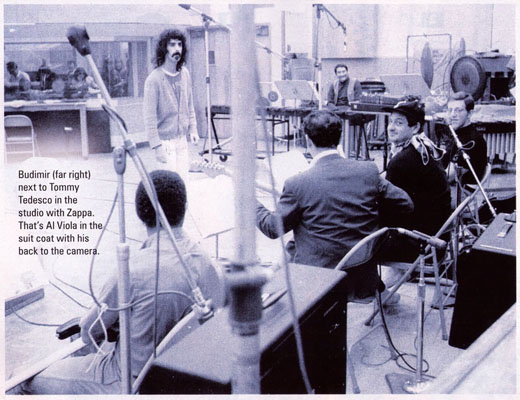
[Dennis] Budimir (far right) next to Tommy Tedesco in the studio with Zappa. That's Al Viola in the suit coat with his back to the camera.
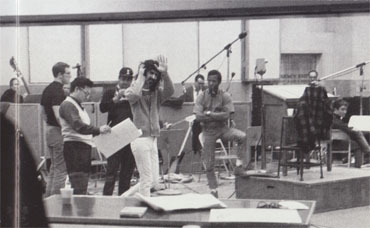
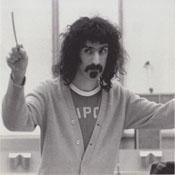
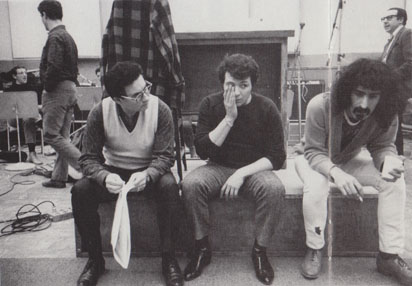
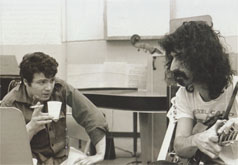
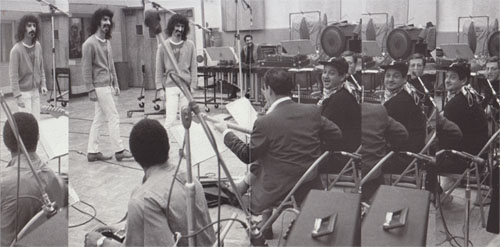

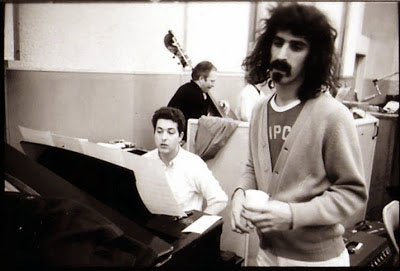
[Mike Lang, unidentified bassist, FZ]
Additional informant: Javier Marcote.
Chorus
Liner notes, 1968
CHORUS: omit last names
LOUIE THE TURKEY
RONNIE WILLIAMS
DICK BARBER FOON THE YOUNGER
ROY ESTRADA
SPIDER
MOTORHEAD
J.K. & TONY
GILLY & THE GIRLS FROM APOSTOLIC (get their names) [*]
ALL NIGHT JOHN & THE OTHER JOHN
CAL
PUMKIN PUMPKIN
LARRY FANOGA
ERIC CLAPTON & CHARLOTTE
MONICA
JIMMY CARL BLACK (the indian of the group)
ALSO:
SAMMY [WHITESIDE]
HAROLD [KELLING]
CHARLIE
BRUCE [HAMPTON]
AND THE REST OF THE GUYS FROM ATLANTA
[*]
MAXINE
GILLY
BECKY
MONICA
Charles Ulrich, April 27, 2006
I've just heard back from John Townley and John Kilgore.
Monica Boscia was the receptionist at Apostolic.
Gilma Townley was the wife (not sister) of John Townley, founder of the studio.
Unknown Girl #1 was Becky Wentworth, general helper at the studio.
Unknown Girl #2 and/or Maxine remains unidentified.
"The other John" could well be John Townley; he was in the studio and occasionally in the piano. "Tony" could be Tony Bongiovi, Apostolic engineer (and second cousin of Jon Bon Jovi).
John Townley (The Other John)
Charles Ulrich, July 1, 2004
John Townley, who owned Apostolic Studios and who may or may not be heard on Lumpy Gravy, was the bass player in The Magicians, the band of songwriters Gary Bonner and Alan Gordon, who wrote "Happy Together" and numerous other Turtles songs.
J. K. Adams
Charles Ulrich, July 7, 2009
J. K. Adams was a composer who was recording musique concrète at Apostolic Studios.
Hampton Grease Band (The Guys From Atlanta)
I went to New York with Charlie [Phillips] and Bruce [Hampton] after the IV of IX broke up. We saw Frank Zappa on the street and I just walked up to him and said 'Grease' with no particular context in mind. Somehow we communicated to him our compatible weirdness, and he invited us to the recording studio, where part of our conversation was recorded and used on Lumpy Gravy. We put 'Grease' together with 'Hampton' for the band's name because he was our only vocalist.
The first meeting [with FZ] took place by chance in New York in '67, and that led to some members of the band hanging around the studio with Frank, where part of their conversation was recorded and used on Zappa's LP Lumpy Gravy.
I knew Frank in the middle and late sixties. He was very much a gentleman to me an everybody around him. I was a nineteen year old kid. We did a cameo on Lumpy Gravy. Sam Whiteside was with me.
[...] Actually that's how I met Frank Zappa. I was discussing [Krzysztof Penderecki's Threnody To The Victims Of Hiroshima]. We were in a cafe, and one of us overheard the other one talking about it, and said "How did you know that record?" That's sort of how we became friends.
Bruce Hampton, interviewed by Rob Turner, Jambands.com, June 2000
I met Frank in New York. I had no idea who he was. It was the mid-sixties; he had just gotten there from LA. I was at a place called The Tin Angel on Bleeker Street, which was across the street from the Garrick Theater, and in he walked, and I just said, 'what a weird poot that guy is.' I mean, this guy had long hair down to his knees. I had never seen anything like that coming from the South in the sixties.
He was just, you know *freaked out* looking. I looked at him, but I didn't say anything, I was just like, 'that guy is poofed out.' I mean I really didn't like him. I was in the Blues Police or the Jazz Police at the time. I wasn't open to any weirdness at all. It had to be avant garde, or it had to be blues or R+B. So then the next day I was at another place on Bleeker Street called the Dugout, I think it's still there. You know, a sandwich place, or a bar, and we were eatin'. He came in again at about the same time, 'round noon or something. I was talking to my friend. I was talking about a Polish composer named Krysztof Penderecki, and he heard me, and he went, "Penderecki?!" And I turned to him and said, 'yeah, do you know who he is?' And he goes, "yeah, very well, I have all of his stuff." He sort of invited us to his house, and we came over. We ended up hanging out every day for about a week or so. We went to his shows, and the first show I heard I really didn't like it at all. I just didn't like it a bit. The second show I went to, I thought, 'man this guy is putting Stravinsky to rock n' roll. He's truly mixing classical music and every influence there is.' I really, really liked it the second time I went and I was more open. The musicianship and the whole thing was just amazing. Frank was such a gentleman it was unbelievable. It actually fried me that anybody could be that gentlemanly. I didn't know that people could be that nice. He wasn't anybody at the time, he had no name. I haven't told this story to many people, but one time we were walking through Washington Square Park, and there was this girl crying. He went twenty feet out of his way, and went over there to this 18 year old girl and cheered her up, spent ten minutes with her, had no idea who she was. In New York no one will ever do that for anyone. And I just said, 'what an amazing guy.'
[...] The guy was nothing but a class gentleman. I really sort of lost touch after about 1980, I only saw him one or two more times. But during the sixties and seventies I stayed very tight with him. I got to do cameo appearances on "We're Only In It For The Money," and "Lumpy Gravy." He was just a class, class cat. I wish the world were full with him. He was just amazing, what did he do 50 albums, and he had four kids? I mean, my God! (laughs) An amazing cat to say the least. He never ran out of energy, man!
Eric Clapton & Charlotte Martin
Charles Ulrich, May 13, 2004
In the [3/3/76 Copenhagen backstage] interview, FZ says that the mention of Eric Clapton [and his girlfriend Charlotte] is a mistake; EC is not on Lumpy Gravy.
The People Inside The Piano
I got bored with the project that I was working on momentarily and I just started sticking people inside a piano to see what would happen. It got so great, I spent three days doing it.
IT: On Lumpy Gravy you have a series of outrageous conversations, are they real or made up?
Z: Both, they're combined. Some of the conversations were steered in certain directions. You just stick a few people together and tell them to talk about a certain thing. They were actually with their heads inside a grand piano. There was a weight on the sustain pedal so the strings were resonant: they were in this darkened room with a cloth over the lid of the piano and there's 3 or 4 people inside with 2 microphones.
FZ, interviewed by Don Menn, Zappa!, 1992
It started to become a trendy thing to do at this particular studio [Apostolic]. Like the receptionist out there would go, "They're in there in the piano again, ha ha ha." And the next thing you know, she's one of the people in the piano. So the cast of characters that wandered in and out of the piano covered everybody from Motorhead and [bass guitarist] Roy Estrada to the sister of the guy who owned the recording studio to Monica the Albanian receptionist to bunches of other people whose names I can't even remember. They just happened to be there, and I said, "Do you want to go in the piano?" And they said, "Yes."
In 1967, we spent about four months recording various projects ("UNCLE MEAT", "WE'RE ONLY IN IT FOR THE MONEY", "RUBEN & THE JETS", and "LUMPY GRAVY") at APOSTOLIC STUDIOS, 53 E. 10th St. NYC. One day I decided to stuff a pair of U-87's in the piano, cover it with a heavy drape, put a sand bag on the sustain pedal and invite anybody in the vicinity to stick their head inside and ramble incoherently about the various topics I would suggest to them via the studio talk-back system.
This set-up remained in place for several days. During that time, many hours of recordings were made, most of it useless. Some of the people who took the challenge included Spider Barbour (leader of the rock group "CHRYSALIS" which was also recording at Apostolic when we weren't booked in), All-Night John (the studio manager), Gilly Townley (sister of the guy who owned the studio), Monica (the receptionist), Roy Estrada and Motorhead Sherwood (members of the "MOTHERS OF INVENTION"), Louis Cuneo (a guy who used to come to our live shows at the Garrick Theater and laugh like a psychotic turkey), and a few others.
During the New York days Frank did lots of seemingly strange things in the studio, trying for a new effect or an unusual blend of instruments. As time went by, less and less of what went on seemed strange to me. One notorious experiment was called 'piano people' [...]. In the studio at Apostolic was a big grand piano, a nice instrument with remarkable resonance. With the pedal held down it would just ring forever. Frank discovered by accident one day that when you spoke near it the appropriate sympathetic strings would resonate. So we clamped down the pedal and draped tarps and rugs over the open lid, sort of forming a little cave. Frank would put people in there and tell them to talk about various topics and we'd record it. Then we'd chop up these ringing words and use bits and pieces here and there. It became a kind of standing joke after a while. Delivery people would show up and he'd run out and grab them and stick them into the piano. It intimidated a lot of people—there were actually people who fled from the studio crying! But Frank didn't care, they were all just grist for his mill.
Session #1—Louis Cuneo, Roy Estrada & Motorhead
Another [Garrick Theatre] regular was a guy we called "Louie the Turkey"—because
of his laugh. His real name was Louis Cuneo. He wound up on the Lumpy Gravy album as one of the people talking about incomprehensible stuff, inside
a piano.
We would always know when Louie was in the theater because we could hear him
in the back of the room. I would invite him onstage, give him a stool to sit
on, hand him the microphone and stop the music. He would sit there and laugh
—at nothing—and the whole audience would laugh with him for five minutes.
Then we thanked him, and he'd leave.
As I passed the summer going daily to the [Garrick] theater, Frank invited me to come over to the studio for a recording session. Initially, we went to his hotel room to pick something up. [...] He had his drummer and base player with us. We stayed there for a short time and left without any drama happening.
When we arrived at the studio, it was completely empty and silent. Frank quickly went to work with us. He brought us to a piano, requested that we put our heads inside of the open top, then he covered the whole musical instrument with a blanket and asked us to remain silent with our eyes shut. After five minutes we (the drummer, base player, I) were told to imagine that we just awakened, not knowing where we were, how we got there or how long we have been there. The drummer spoke first, I believe, about finding himself in that piano without knowing how he got there . . .
For the next three hours Frank taped us talking about whatever came into our heads. I didn't have any idea what he wanted or what he planned to do with the recording session. It was just plain out good fun! The rest is history.
Session #2—Spider Barbour, Monica & John Kilgore
Spider Barbour
SPIDER (from a group that hasn't destroyed your minds yet . . .) is the one who wants you to turn your radio around.
Spider [Barbour] began his musical career in 1968 in a band called Chrysalis. He also spoke (under the piano lid) on Frank Zappa's 1968 album "Lumpy Gravy" while Chrysalis and the Mothers of Invention were recording projects at the same studio in New York City.
His name is Spider Barbour. And he was the, uh— You know Spider? . . . Alright, that's right. They were working at the studio in New York where we recorded Ruben & The Jets and Uncle Meat. They were— We had eight hours a day, they had eight hours a day, and so I— He had an interesting voice, so I said, "Why don't you just climb inside this piano here with these other people and start talking?" And that's where all that dialog came from.
[...] We did three days of that.
Session #3—Gilly Townley, Maxine, Becky & Larry Fanoga
More People Inside The Piano
Kent Nagano, "Premiering Zappa with the London Symphony Orchestra," Zappa!, 1992, p. 8-11
[In 1982] I asked Frank for examples of some of his other works, and he played me an improvisation where he had locked some people inside a grand piano and left them there for a long time with a microphone inside and a tape recorder running. It was a theater piece, but it made a fascinating improvisation. The tones were amazing: humans trapped inside a grand piano for hours on end, creating sympathetic vibrations on the strings and experiencing the gradual drifting away from rational to irrational thought. The sounds coming off of his tape were certainly as experimental as the most experimental work that I'd ever heard by composition students.
I set up a big blanket over the Bösendorfer piano and taped the sustain pedals down with elaborate microphones. When anyone stood inside the 'tent' and talked, the strings would vibrate to their voices and it made them sound like they were in this giant cave. It was a remarkable series that I taped on the two track in boxes that I only labelled 'Outtakes, one though 136' reel numbers, or something like that. When musicians visited, we would put them in there and let them talk about anything. But the basic story was they were in search of 'The Big Note'. I don't think that the Zappa Family Trust even knows they have them as I am the only one that knows what they look like.

